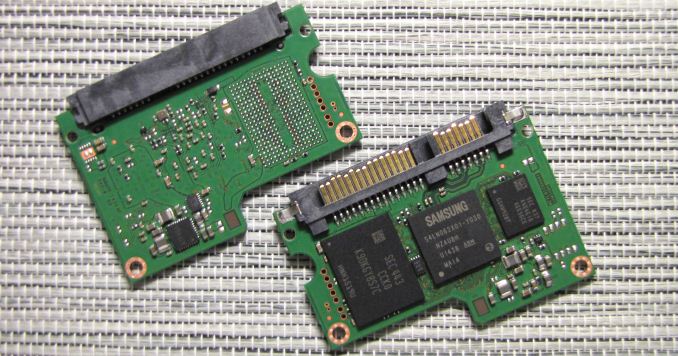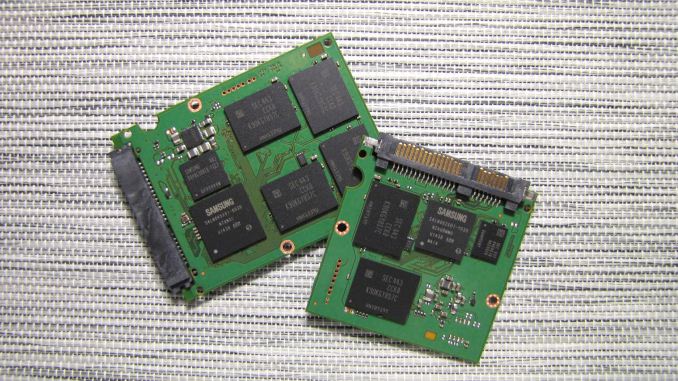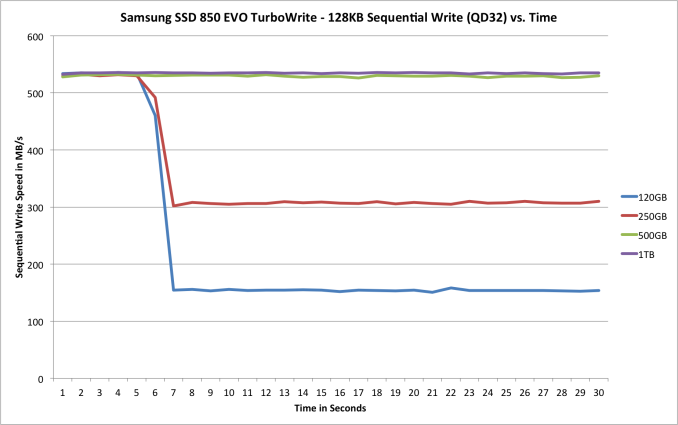Samsung SSD 850 EVO (120GB, 250GB, 500GB & 1TB) Review
by Kristian Vättö on December 8, 2014 10:00 AM ESTInside The Drives
There are three different PCB designs in the 850 EVO lineup. The 120GB and 250GB models (above) use a tiny PCB with room for two NAND packages (one on each side). Interestingly enough, both use octal-die packages, meaning that the 120GB 850 EVO only has a single 128GB (8*16GB) NAND package. Decoding the part number reveals that the packages are equipped with eight chip enablers (CEs), so a single NAND package is viable since all eight dies can be accessed simultaneously.
The use of octal-die packages is actually true for all capacities. It's an interesting choice nevertheless, but I suspect Samsung's packaging technology is advanced and mature enough that it's more cost efficient to use high die count packages and small PCBs instead of larger PCBs with more and less dense NAND packages.
| Samsung SSD 850 EVO NAND Configurations | ||||
| Capacity | 120GB | 250GB | 500GB | 1TB |
| # of NAND Packages | 1 | 2 | 4 | 8 |
| # of Die Per Package | 8 | 8 | 8 | 8 |
| Total # of Die | 8 | 16 | 32 | 64 |
| Die Capacity | 128Gbit | 128Gbit | 128Gbit | 128Gbit |
| Raw NAND Capacity | 128GiB | 256GiB | 512GiB | 1024GiB |
| Over-Provisioning | 12.7% | 9.1% | 9.1% | 9.1% |
TurboWrite
TurboWrite is a feature that Samsung brought to the 840 EVO to increase write performance. The idea of running a small portion of the NAND in SLC mode was nothing new, but it was the first time it truly made sense because the 840 EVO used slower TLC NAND and hence the SLC buffer could provide significant improvements to write performance and user experience. Unsurprisingly, TurboWrite is also present in the 850 EVO.
| Samsung SSD 850 EVO TurboWrite SLC Buffer Size | ||||
| Capacity | 120GB | 250GB | 500GB | 1TB |
| TurboWrite Buffer Size | 3GB | 3GB | 6GB | 12GB |
The buffer sizes and core architecture have remained unchanged. All writes hit the SLC buffer first, from which they then get moved to the TLC array during idle time. The only exception is a case of long, sustained period of writes that exceeds the buffer size, in which case the data will be written straight to the TLC portion.
| Write Performance With and Without TurboWrite | ||||
| With TurboWrite | Without TurboWrite | |||
| Sequential Write | 4KB Random Write (QD32) | Sequential Write | 4KB Random Write (QD32) | |
| 120GB | 520MB/s | 88K IOPS | 150MB/s | 38K IOPS |
| 250GB | 520MB/s | 88K IOPS | 300MB/s | 70K IOPS |
| 500GB | 520MB/s | 90K IOPS | 500MB/s | 80K IOPS |
| 1TB | 520MB/s | 90K IOPS | 520MB/s | 80K IOPS |
Samsung's reviewer's guide states that the 850 EVO features "enhanced TurboWrite technology" with a focus on random write performance, but I don't have any additional details as to how the TurboWrite implementation in the 850 EVO differs from the 840 EVO. TurboWrite was always designed to cache all writes regardless of the nature of the write (random vs sequential), so I'm not sure if anything has actually changed. Obviously the algorithms have been optimized for the new NAND and controller architecture and it's possible that the whole batch of algorithms has improved in the process, but I'll provide an update when I hear back from Samsung.
I ran a quick sequential write test to see how TurboWrite behaves in the 850 EVO. At smaller capacities it clearly provides a tremendous performance boost, but at 500GB and 1TB there is enough NAND to provide the parallelism that is needed to max out the SATA 6Gbps interface. That is a big improvement over the 840 EVO as its write performance maxed out at ~400MB/s when writing to the TLC array, so the performance benefits of 3D NAND technology are already evident.













97 Comments
View All Comments
Kevin G - Monday, December 8, 2014 - link
They do seem a little low but we just got out of a major sale spree. During the Black Friday/Cyber Monday shopping fest the 480 GB Intel 730 was going for $200. I would have picked up one up myself at that price but they ran out of stock.HisDivineOrder - Wednesday, December 10, 2014 - link
You'd have been better served with the Sandisk Extreme Pro 480GB for $185.davolfman - Monday, December 8, 2014 - link
OCZ's firmware for the Barefoot3 series of chips the ARC100 uses has a less then stellar reputation. Things like unexpected power loss have been known to put it into a state of progressive corruption only recoverable by secure erase. There have been patches that claim to fix this on my Vector (that probably got applied to the ARC out the door), but I haven't seen anyone test if they're working.Oxford Guy - Wednesday, December 31, 2014 - link
Up to its old tricks, then.Kristian Vättö - Tuesday, December 9, 2014 - link
As listed on the table, the prices were taken on December 7 and were accurate at the time.sheh - Monday, December 8, 2014 - link
Can anyone explain the large discrepancy (not only in this case) in sequential speed between Iometer and AS-SSD?Kristian Vättö - Tuesday, December 9, 2014 - link
It's because of TurboWrite. Iometer is a time based tool and the sequential tests are run for one minute, which means that the TurboWrite buffer will be filled and thus the performance goes down as data is written to the TLC array. AS-SSD, on the other hand, only writes a gigabyte of data so it all gets written to the fast SLC cache.sheh - Friday, December 12, 2014 - link
Thanks. I'll have to reread older reviews, but I think there's a similar behavior also on other drives that do not have a fast temporary buffer?maecenas - Monday, December 8, 2014 - link
I saw the 840 EVO 500gb going for $180 over the black Friday - cyber Monday period. It'll interesting to see if Samsung keep the 840 EVO on the market as a the low end, so the 850 EVO can fill the mid-range portion of the market while the 850 Pro serves the high end.Laststop311 - Monday, December 8, 2014 - link
Prices are kinda crappy. Why go with an 850 evo when u can spend 20-30 dollars more and get an 850 pro?